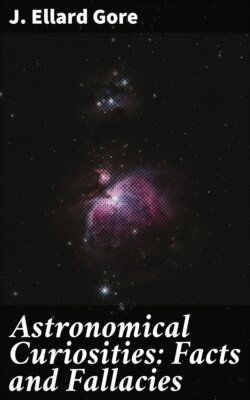Читать книгу Astronomical Curiosities: Facts and Fallacies - J. Ellard Gore - Страница 7
CHAPTER IV
ОглавлениеThe Earth
The earth being our place of abode is, of course, to us the most important planet in the solar system. It is a curious paradox that the moon’s surface (at least the visible portion) is better known to us than the surface of the earth. Every spot on the moon’s visible surface equal in size to say Liverpool or Glasgow is well known to lunar observers, whereas there are thousands of square miles on the earth’s surface—for example, near the poles and in the centre of Australia—which are wholly unknown to the earth’s inhabitants; and are perhaps likely to remain so.
Many attempts have been made by “paradoxers” to show that the earth is a flat plane and not a sphere. But M. Ricco has found by actual experiment that the reflected image of the setting sun from a smooth sea is an elongated ellipse. This proves mathematically beyond all doubt that the surface of the sea is spherical; for the reflection from a plane surface would be necessarily circular. The theory of a “flat earth” is therefore proved to be quite untenable, and all the arguments (?) of the “earth flatteners” have now been—like the French Revolution—“blown into space.”
The pole of minimum temperature in the northern hemisphere, or “the pole of cold,” as it has been termed, is supposed to lie near Werchojansk in Siberia, where a temperature of nearly -70° has been observed.
From a series of observations made at Annapolis (U.S.A.) on the gradual disappearance of the blue of the sky after sunset, Dr. See finds that the extreme height of the earth’s atmosphere is about 130 miles. Prof. Newcomb finds that meteors first appear at a mean height of about 74 miles.[57]
An aurora seen in Canada on July 15, 1893, was observed from stations 110 miles apart, and from these observations the aurora was found to lie at a height of 166 miles above the earth’s surface. It was computed that if the auroral “arch maintained an equal height above the earth its ends were 1150 miles away, so that the magnificent sight was presented of an auroral belt in the sky with 2300 miles between its two extremities.”[58]
“Luminous clouds” are bright clouds sometimes seen at night near the end of June and beginning of July. They appear above the northern horizon over the sun’s place about midnight, and evidently lie at a great height above the earth’s surface. Observations made in Germany by Dr. Jesse, and in England by Mr. Backhouse, in the years 1885-91, show that the height of these clouds is nearly constant at about 51 miles.[59] The present writer has seen these remarkable clouds on one or two occasions in County Sligo, Ireland, during the period above mentioned.
M. Montigny has shown that “the approach of violent cyclones or other storms is heralded by an increase of scintillation” (or twinkling of the stars). The effect is also very evident when such storms pass at a considerable distance. He has also made some interesting observations (especially on the star Capella), which show that, not only does scintillation increase in rainy weather, but that “it is very evident, at such times, in stars situated at an altitude at which on other occasions it would not be perceptible at all; thus confirming the remark of Humboldt’s with regard to the advent of the wet season in tropical countries.”[60]
In a paper on the subject of “Optical Illusions” in Popular Astronomy, February, 1906, Mr. Arthur K. Bartlett, of Batter Creek, Michigan (U.S.A.), makes the following interesting remarks:—
